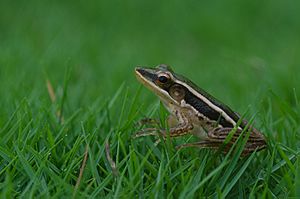Hylarana tytleri facts for kids
Quick facts for kids Hylarana tytleri |
|
|---|---|
 |
|
| Conservation status | |
| Scientific classification |
Hylarana tytleri is a fascinating frog species also known by several cool names like the Theobald's ranid frog, yellow-striped frog, leaf frog, and leaping frog. It belongs to the family called Ranidae, which includes many common frogs you might know. These frogs are found in parts of Asia, specifically in eastern and northeastern India, Bangladesh, and southern Nepal. You might also find them in lower elevations of Bhutan.
Contents
About the Theobald's Ranid Frog
The Theobald's ranid frog is a type of frog that loves to live near water. Like most frogs, it has smooth, moist skin and strong back legs that are perfect for jumping.
What Does It Look Like?
This frog is often called the "yellow-striped frog" because it can have yellowish stripes on its body. Its skin color helps it blend in with its surroundings, like leaves and mud, which keeps it safe from predators. Frogs generally have big eyes that help them see all around, especially at night when they are most active.
Where Does It Live?
Hylarana tytleri prefers to live in places with plenty of water, such as ponds, swamps, and slow-moving streams. These areas are usually found in forests or open grasslands near water sources. The warm, humid climate in countries like India and Bangladesh is perfect for these amphibians. They need water not just for drinking, but also for laying their eggs and for their young to grow.
What Does It Eat?
Like most frogs, Hylarana tytleri is a carnivore, which means it eats other animals. Its diet mainly consists of small insects like flies, mosquitoes, and beetles. It uses its long, sticky tongue to catch its prey very quickly. Frogs are important for controlling insect populations in their habitats.
Life Cycle and Reproduction
The life cycle of the Theobald's ranid frog is similar to that of many other frogs. It starts with eggs laid in water, often attached to plants. These eggs hatch into tadpoles, which are tiny, fish-like creatures that live entirely in water. Tadpoles breathe through gills and feed on algae and other tiny plant matter.
As tadpoles grow, they slowly change. They develop back legs first, then front legs. Their tails gradually shrink, and their gills are replaced by lungs, allowing them to breathe air. Eventually, they transform into small froglets, which then grow into adult frogs. This amazing process is called metamorphosis.
Why Is It Called a "Leaping Frog"?
One of the common names for Hylarana tytleri is the "leaping frog." This name probably comes from its excellent jumping ability. Frogs are known for their powerful hind legs, which allow them to make long, quick leaps. This skill is very useful for catching prey and escaping from danger.
Is It in Danger?
The conservation status of Hylarana tytleri is listed as "Least Concern" by the IUCN (International Union for Conservation of Nature). This means that, for now, this frog species is not considered to be at high risk of disappearing. However, like all wildlife, it's important to protect their habitats to ensure they continue to thrive.
Images for kids
See also
 In Spanish: Hylarana tytleri para niños
In Spanish: Hylarana tytleri para niños



